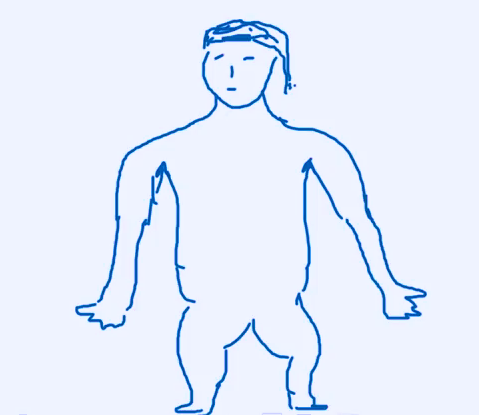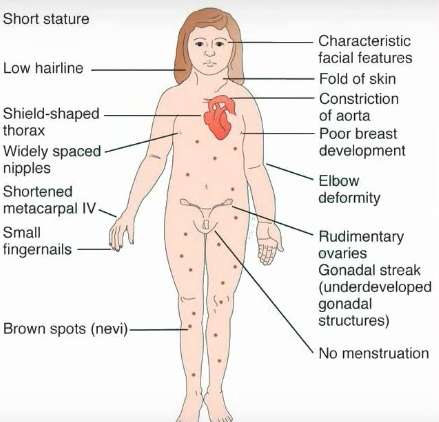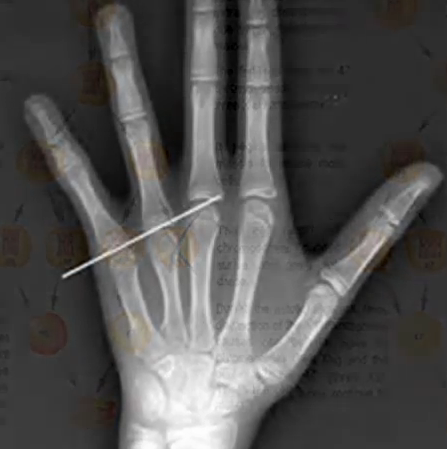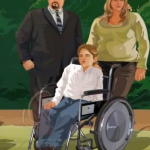Turner syndrome is a genetic disorder affecting females. The genes of the affected person are abnormal. In this one of the sex chromosomes i.e. X chromosome is either abnormal or is missing completely. Where normally a female has 46 chromosomes, including 2 X-chromosomes, in Turner’s syndrome, there is only one X chromosome. In certain conditions the X chromosome is missing only in some cells and not others known as Turner’s mosaicism. It is also commonly known as Bonnevie-Ullrich-Turner syndrome or Ullrich-Turner syndrome in Europe. A teenager from London with a 45X karyotype was the first case of this disorder.
Turner’s syndrome is found in almost 0.05% of the female population. As a genetic disorder it primarily affects the sexual development of females. Physical abnormalities include dysfunctional ovaries, short stature, infertility, amenorrhea, sexual dysfunction, lack of cognitive growth such as in memory, learning, mathematical, logical, and spatial skills, webbed neck with low-set ears. Heart and kidney disorders often come as a part of Turner’s syndrome.
Causes of Turner Syndrome
Although the genetic role in occurrence of the disorder is a known fact, the predisposing factors however have been unknown so far. Almost two thirds of the patients have a dysfunctional X chromosome, and is paternal in origin. Its main cause therefore is still being researched and certain theories are supporting its development as well. One being that while conception a part of the sex chromosomes does not get passed down to the female fetus causing either the complete absence of one X chromosome or an abnormal X chromosome.
Turner Syndrome Symptoms
The symptoms in each female patient are generally different. Till now there hasn’t been a case where two patients share the same signs. However due to the defect in sex chromosomes, the syndrome could manifest the following conditions:
- A short stature with a webbed neck, Broad and shield like chest.
- Swelling in the hands or feet.
- Low set ears and hairline.
- Improper or poor development of the breasts, wide spaced nipples and Sparse pubic hair.
- Abnormal gonads or ovaries.
- Vaginal dryness and Infertility.
- Absence of menstruation.
- Obesity
- Small and fragile fingernails
- Turned-in elbows
- Dryness in eyes that is chronic and eyelids are usually drooping.
- Pigmented moles.
- Structural defects in the aorta and the aortic valve
- Kidney and heart disorders such as Misshapen kidneys also known as horse-shoe.
- The hip-waist ratio is extremely poor with smaller hips that are same in size as the waist.
- Poor cognitive ability with difficulties in paying attention, learning, spatial and social skills.
Diagnosis
It can be diagnosed at any stage of life and also during fetal development. But it is commonly detected prior to birth with the help of amniocentesis where chromosome analysis is done with the specimen. It can also be done in ultrasounds where abnormalities in kidneys as well as heart are confirmed.
In order to detect the exact problem karyotyping is done to examine the chromosomes and chromosomal compositions through a blood test to determine the scale of follicle stimulating hormone and luteinizing hormone that are affected by the change in estrogen levels.
Other diagnostic tests include MRI, Echocardiogram, MRI, and pelvic exam to test the condition of the ovaries and kidneys.
Treatment
The treatment usually focuses on the betterment of sexual growth and functioning of the woman. Because of the chromosomal aberrations and genetic abnormality it is not curable but there are a few treatments that can be adopted to deal with the symptoms. These are as follows:
- Growth Hormone Therapy: It focuses on the bone growth to reach an average height at an early stage and if not done, it the females will not grow more than four to five feet.
- Estrogen Replacement Therapy: Here, Sex hormones are given to correct the sexual development starting when the patient is 12 years old. It works on breast development and pubic hair as well as other secondary sexual parts. The ones who do not receive this therapy are most likely to have osteoporosis.
- 3. Assisted Reproduction Techniques: women are usually assisted by their physicians for reproduction techniques to get pregnant such as using donor eggs that eventually become embryo.
Turner Syndrome Life expectancy
Although it is a lifelong condition but with careful treatments and monitoring the patient can live a normal life. However there are a few conditions that could be fatal. Females with this Syndrome can reach as old as 50 years of age. In cases of complications or delay in the diagnosis death can occur because of kidney and heart problems. If it is a fetal condition then the uterus would either be still born or aborted at an early stage of conception otherwise it will lead to congenital anomalies.
Cardiovascular disorders can play an essential part in overall mortality and life expectancy (minimum 13 years). The prognosis is therefore dependent on a number of conditions. It is extremely important to give the females an overall support especially during adolescence to deal with body image problems and infertility.
Pictures




